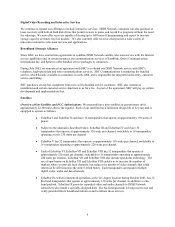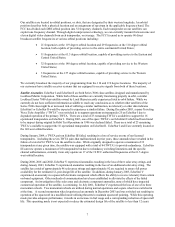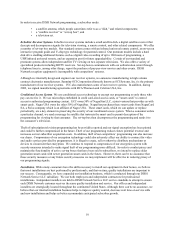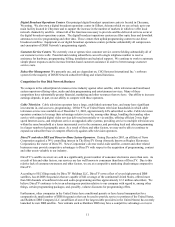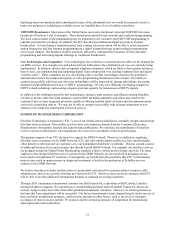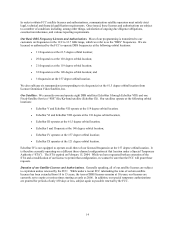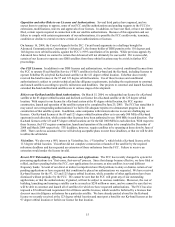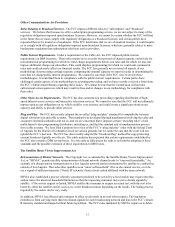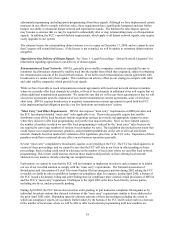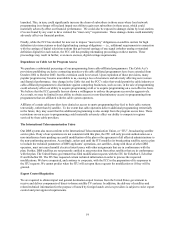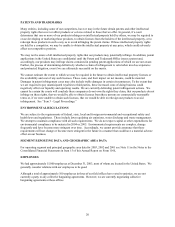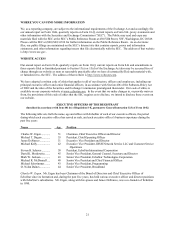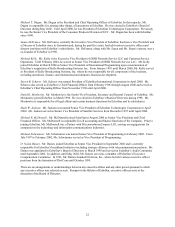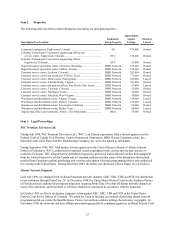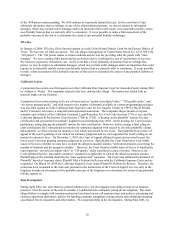Dish Network 2003 Annual Report Download - page 21
Download and view the complete annual report
Please find page 21 of the 2003 Dish Network annual report below. You can navigate through the pages in the report by either clicking on the pages listed below, or by using the keyword search tool below to find specific information within the annual report.16
New Satellite License Auction Proceedings. The FCC has proposed to auction licenses for DBS frequencies at the
61.5 degree, 157 degree, 166 degree and 175 degree orbital locations. Rainbow, a DBS licensee with a satellite at
the 61.5 degree orbital location, has argued that we should not be eligible to bid for two available channels at the
61.5 degree orbital location. If this argument is accepted by the FCC, it will prevent us from acquiring these
channels and making more productive use of the satellite operating at that orbital location. On January 15, 2004,
the FCC affirmed that it had the necessary auction authority and that no eligibility restrictions were warranted for
the 157, 166 and 175 degree licenses. It deferred the question of eligibility restrictions that would preclude us from
bidding for the 61.5 degree license to a separate order.
Expansion DBS Spectrum. The FCC has also allocated additional expansion spectrum for DBS services
commencing in 2007. This could create significant additional competition in the market for subscription television
services. We filed applications for such additional spectrum during March 2002 but cannot predict whether the FCC
will grant these applications.
Other Services in the DBS band. The FCC has also adopted rules that allow non-geostationary orbit fixed satellite
services to operate on a co-primary basis in the same frequency as direct broadcast satellite and Ku-band-based fixed
satellite services. In the same rulemaking, the FCC authorized use of the DBS spectrum that we use by terrestrial
communication services. The FCC recently auctioned licenses for these terrestrial services during January, 2004.
We are a passive investor in one of the winning bidders in the auction, but we cannot be sure that licenses will in
fact be awarded to that bidder. Also, there can be no assurance that operations by non-geostationary orbit fixed
satellite services or terrestrial communication services in the DBS band will not interfere with our DBS operations.
Proposals to allow 4.5 Degree Spacing. During April 2002, SES Americom, Inc. requested a declaratory ruling that
it is in the public interest for SES Americom to offer satellite capacity for third party direct-to-home services to
consumers in the United States and certain British Overseas Territories in the Caribbean. SES Americom proposes
to employ a satellite licensed by the Government of Gibraltar to operate in the same uplink and downlink frequency
bands as us, from an orbital position located in between two orbital locations where EchoStar and DirecTV have
already positioned satellites. DirecTV, which opposes SES’s petition, has itself filed a petition for rulemaking for
standards to permit such 4.5 degree spacing. On January 23, 2004, we filed comments in response to DirectTV’s
petition for rulemaking. We stated in these filings that we believe 4.5 degree spacing is feasible and noted that we
ourselves have filed applications for satellites located 4.5 degrees from existing DBS satellites. We acknowledged,
however, that such narrow spacing presents risks of interference with current DBS operations. DirecTV has recently
requested FCC authority to provide service to the United States from a Canadian orbital slot. The possibility that the
FCC will allow service to the U.S. from closer-spaced DBS slots and from foreign slots may permit additional
competition against us from other DBS providers.
Rules Relating to Alaska and Hawaii. The holders of DBS authorizations issued after January 19, 1996 must
provide DBS service to Alaska and Hawaii if such service is technically feasible from the authorized orbital
location. Our authorizations at the 110 degree, 148 degree and 157 degree orbital locations were received after
January 19, 1996. While we provide service to Alaska and Hawaii from both the 110 and 119 degree orbital
locations, those states have expressed the view that our service should more closely resemble our service to the
mainland United States and otherwise needs improvement. Further, the satellite we currently operate at the 148 and
157 degree orbital locations are not able to provide service to Alaska and/or Hawaii. We received temporary waivers
of the service requirement for the 148 degree orbital location subject to several conditions and have requested a
similar waiver for the 157 degree orbital location. However, the FCC could revoke these waivers or reject our
request for a new waiver at any time.
The FCC has also concluded a rulemaking which seeks to streamline and revise its rules governing DBS operators.
In connection with this rulemaking, the FCC clarified its geographic service requirements to introduce a requirement
that we provide programming packages to residents of Hawaii and Alaska that are “reasonably comparable” to what
we offer in the contiguous 48 states. We cannot be sure that this requirement will not affect us adversely by
requiring us to devote additional resources to serving these two states.


